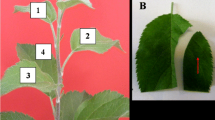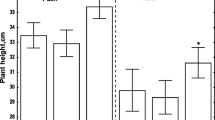Summary
Browning of potato tubers infected withPhytophthora infestans was correlated with field resistance. The composition of brown material extracted from tubers was investigated by preparing alkaline-neutral difference spectra, which were similar to those obtained from a model system of tuber cell walls incubated with ferulic or p-coumaric acids and H2O2. The activities of L-phenylalanine ammonia lyase, peroxidase and phenolase in wounded tissue were correlated with resistance. After infection, peroxidase and phenolase activities were reduced, the greatest reduction being in the most resistant variety. The relation between field resistance and wounding is discussed.
Zusammenfassung
Ein Vergleich von drei Kartoffelsorten unterschiedlicher unspezifischer Resistenz (Feldresistenz) gegenPhytophthora infestans zeigte, dass eine zunehmende Resistenz positiv korreliert war mit einer verstärkten Bräunung des Knollengewebes nach der Infektion. Der Grad der Eindringung des Pilzmyzels war mit der Resistenz negativ korreliert und die Suberinisierung der Schnittfläche vor der Inokulation erhöhte die Resistenz gegen die Eindringung (Abb. 1). Aus dem infizierten Gewebe wurde mit Phenol-Essigsäure-Wasser (PAW) mehr braunes Material und von dunklerer Farbe herausgelöst als aus dem nicht infizierten Gewebe. Die Substanz enthielt Chlorogensäure oder andere Chinasäureester (Tab. 1). Die Differenz-Spektren der Phenol-Essigsäure-Wasser-Extrakte im alkalischen bzw. neutralen Bereich von infiziertem und nicht infiziertem Gewebe waren unterschiedlich, was auf Unterschiede in dem phenolischen Material, das in die Zellwände eingelagert wurde, hinwies (Abb. 3). Die Spektren waren ähnlich denen, die mit einem Modellsystem aus Knollenzellwänden mit zugesetzter Ferula-oder p-Cumarsäure und H2O2 erzielt wurden (Abb. 4). Im verletzten Gewebe waren die Aktivitäten der Enzyme L-Phenylalaninammoniumlyase, Peroxidase und Phenolase mit der Sortenresistenz korreliert (Tab. 3–5). Nach der Infektion waren die Aktivitäten der Phenolase und der Peroxidase vérringert und die Abnahme war mit der Resistenz korrliert. Die Ausprägung der unspezifischen Resistenz in Knollen scheint auf zwei Faktoren zu beruhen: der Fähigkeit des Gewebes nach der Verletzung Suberin zu bilden, um das Eindringen des Erregers zu hemmen und der Produktion von zusätzlichen braunen Phenolverbindungen, die in die Wirtszellwände eingelagert werden und dadurch deren Struktur so verändern, dass eine Eindringung des Pilzes begrenzt wird.
Résumé
Une étude portant sur trois variétés de pomme de terre présentant une différence de résistance au champ vis à vis dePhytophtora infestans montre qu'une augmentation de résistance est corrélée positivement à un brunissement croissant des tissus du tubercule après contamination. Le taux de pénétration du mycélium est corrélé négativement à la résistance; la subérisation de la surface coupée avant contamination augmente la résistance à la pénétration (fig. 1).
La substance obtenue par extraction dans un mélange phénol-acide acétique-eau est plus brunâtre et de couleur plus sombre lorsque le tissu est contaminè par rapport à un tissu non contaminé. L'extrait contient de l'acide chlorogénique ou d'autres esters d'acide quinique (tableau 1). Les spectres obtenus à partir d'extraits du mélange phénol-acide acétique-eau dans les phases alcanine et neutre sont différents entre des tissus contaminés et non-contaminés; ceci indique un changement dans la nature de la substance phénolique déposée dans les parois cellulaires de tubercule avec adjonction d'acides férulique ou p-coumarique et d'H2O2 (fig. 4).
Les activités d'enzymes L-phenylalanine ammonialyase, peroxidase et phénolase (tableaux 3–5) sont corrélés, pour des tissus endommagés, à la résistance variétale. Après contamination, les activités phénolase et péroxidase sont réduites, la diminution étant liée à la résistance.
L'expression de la résistance au champ au niveau des tubercules semble reposer sur deux facteurs: la capacité du tissu à produire la subérine après endommagement afin d'inhiber la pénétration du pathogène et la production de composés phénoliques bruns après contamination, qui se déposent dans les parois cellulaires réceptrices, modifiant ainsi leur structure de façon à limiter la pénétration du champignon.
Similar content being viewed by others
References
Anonymous, 1976. National Institute of Agricultural Botany, Farmers Leaflet 3.
Baruah, P. & T. Swain, 1959. The action of potato phenolase on flavonoid compounds.Journal of the Science of Food and Agriculture 10: 125–129.
Borchert, R., 1974. Isoperoxidases as markers of the wound-induced differentiation pattern in potato tuber.Developmental Biology 36: 391–399.
Brinkman, F. G. & T. Sminia, 1977. Histochemical location of catalase in peroxisomes and of peroxidase in cell walls and Golgi bodies of cells in differentiating potato tuber tissue.Zeitschrift für Pflanzenphysiologie 84: 407–412.
Camm, E. & G. H. N. Towers, 1973. Review article-phenylalanine ammonia lyase.Phytochemistry 12: 961–973.
Clarke, D. D. & M. Y. A. Kassim, 1977. Resistance factors in potato tuber tissue to hyphal growth ofPhytophthora infestans.Physiological Plant Pathology 11: 267–277.
Cottle, W. & P. E. Kolattukudy, 1982. Biosynthesis, deposition and partial characterisation of potato suberin phenolics.Plant Physiology 69: 393–399.
Dicks, J. W. & J. Friend, 1968. The oxidation of carotenoids by mitochondria from sugar beet leaves III: crocin oxidation by a peroxidase system.Phytochemistry 7: 1933–1947.
Friend, J., 1976. Lignification in infected tissue. In: J. Friend & D. R. Threlfall (Eds.), Biochemical aspects of plant-parasite relationships, pp. 291–303. Academic Press, London & New York.
Friend, J. & M. Knee, 1969. Cell wall changes in potato tuber tissue infected withPhytophthora infestans.Journal of Experimental Botany 20: 763–775.
Friend, J., S. B. Reynolds & M. A. Aveyard, 1973. PAL, chlorogenic acid and lignin in potato tuber tissue inoculated withPhytophthora infestans.Physiological Plant Pathology 3: 495–507.
Henderson, S. J., 1975. Role of lignin in the defence reaction ofSolanum tuberosum L. following attack byPhytophthora infestans (Mont.) de Bary. Ph.D. Thesis, University of Hull.
Jarvis, M. C., D. R. Threlfall & J. Friend, 1981. Potato cell wall polysaccharides-degradation with enzymes fromPhytophthora infestans.Journal of Experimental Botany 32: 1309–1320.
Kahn, V., S. Goldschmidt, J. Amir & R. Granit, 1981. Some biochemical properties of soluble and bound potato tuber peroxidase.Journal of Food Science 46: 756–764.
Kolattukudy, P. E. & B. B. Dean, 1974. Structure, gas chromatographic measurement and function of suberin synthesised by potato tuber tissue slices.Plant Physiology 54: 116–121.
Laird, W. M., E. I. Mbadiwe & R. L. M. Synge, 1976. A simplified procedure for fractionating plant materials.Journal of the Science of Food and Agriculture 27: 127–130.
Levy, C. C. & M. Zucker, 1960. Cinnamyl and p-coumaryl esters as intermediates in the biosynthesis of chlorogenic acid.Journal of Biological Chemistry 235: 2418–2425.
Lowry, O. H., N. J. Rosebrough, A. L. Farr & R. J. Randall, 1951. Protein measurement with th Folin phenol reagent.Journal of Biological Chemistry 193: 265–275.
Majak, W. & G. H. N. Towers, 1973. Methods for the isolation and purification of ethanol-insoluble, phenolic esters inMentha arvensis.Phytochemistry 12: 1141–1147.
Malcolmson, J. F., 1976. Assessment of field resistance to blight in potatoes.Transactions of the British Mycological Society 67: 321–325.
Mayer, A. M. & E. Harel, 1979. Polyphenoloxidase in plants.Phytochemistry 18: 193–216.
McLauchlin, J., 1980. Aspects of field resistance of the potato to late blight (Phytophthora infestans). Ph.D. Thesis, University of Hull.
Müller, K. O., 1957. Wound healing of the potato tuber in relation to infection byPhytophthora infestans, (Mont.) de Bary.Australian Journal of Biological Science 10: 189–196.
O'Brien, T. P., N. Feder & M. E. McCully, 1964. Polychromatic staining of plant cell walls by toluidine blue O,Protoplasma 59: 368–373.
Pierpoint, W. S., 1966. The enzymic oxidation of chlorogenic acid and some reactions of the quinone produced.Biochemical Journal 98: 567–580.
Pierpoint, W. S., R. J. Ireland & J. M. Carpenter. 1977. Modification of proteins during the oxidation of leaf phenols: reaction of potato virus X with chlorogenoquinone.Phytochemistry 16: 29–34.
Potty, V. S., 1969. Determination of protein in the presence of phenols and pectins.Analytical Biochemistry 29: 535–539.
Ridge, I. & D. J. Osborne, 1971. Role of peroxidase when hydroxyproline-rich protein in plant cell walls is increased by ethylene.Nature, New Biology 229: 205–208.
Schöber, B., 1971. Physiologische Veränderungen in der Kartoffelknolle nach Verletzung und Infektion mitPhytophthora infestans.Potato Research 14: 39–48.
Stafford, H. A., 1960. Differences between lignin-like polymers formed by peroxidation of eugenol and ferulic acid in leaf sections ofPhleum.Plant Physiology 35: 108–112.
Stafford, H. A., 1964. Comparison of lignin-like products found naturally and induced in tissues ofPhleum, Elodea andColeus, and in a paper peroxidase system.Plant Physiology 39: 350–360.
Thomas, P. & H. Delincee, 1979. Effect of gamma radiation on peroxidase isoenzymes during suberisation of wounded potato tubers.Phytochemistry 18: 917–921.
Whitmore, F. W., 1978. Lignin-carbohydrate complex formed in isolated cell walls of callus.Phytochemistry 17: 421–425.
Author information
Authors and Affiliations
Rights and permissions
About this article
Cite this article
McLauchlin, J. Effect of infection byPhytophthora infestans on phenolics in potato tubers with various degrees of field resistance. Potato Res 26, 261–275 (1983). https://doi.org/10.1007/BF02357122
Accepted:
Issue Date:
DOI: https://doi.org/10.1007/BF02357122




